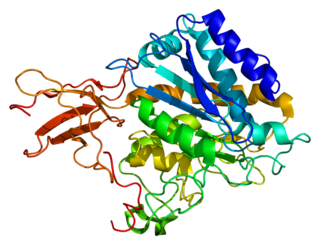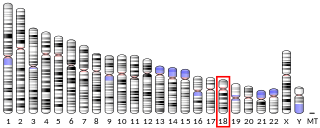
Carboxypeptidase E (CPE), also known as carboxypeptidase H (CPH) and enkephalin convertase, is an enzyme that in humans is encoded by the CPE gene. This enzyme catalyzes the release of C-terminal arginine or lysine residues from polypeptides.

Allograft inflammatory factor 1 (AIF-1) also known as ionized calcium-binding adapter molecule 1 (IBA1) is a protein that in humans is encoded by the AIF1 gene.

Carboxypeptidase M is an enzyme that in humans is encoded by the CPM gene.

Glucosamine—fructose-6-phosphate aminotransferase isomerizing 1 is an enzyme that in humans is encoded by the GFPT1 gene.

Secretory carrier-associated membrane protein 1 is a protein that in humans is encoded by the SCAMP1 gene.

HIG1 domain family member 1A (HIGD1A), also known as hypoglycemia/hypoxia inducible mitochondrial protein1-a (HIMP1-a) and hypoxia induced gene 1 (HIG1), is a protein that in humans is encoded by the HIGD1A gene on chromosome 3. This protein promotes mitochondrial homeostasis and survival of cells under stress and is involved in inflammatory and hypoxia-related diseases, including atherosclerosis, ischemic heart disease, and Alzheimer’s disease, as well as cancer.

Beta-Ala-His dipeptidase is an enzyme that in humans is encoded by the CNDP1 gene.

Fas-activated serine/threonine kinase is an enzyme that in humans is encoded by the FASTK gene.

Secretogranin III, also known as SCG3, is a protein which in humans is encoded by the SCG3 gene.

Eukaryotic translation initiation factor 3 subunit L (eIF3l), less commonly known as EIF3EIP, is a protein that in humans is encoded by the EIF3L gene.

Forkhead box protein N3 is a protein that in humans is encoded by the FOXN3 gene.

Porimin is a protein that in humans is encoded by the TMEM123 gene.

Dual specificity protein phosphatase CDC14B is an enzyme that in humans is encoded by the CDC14B gene.

Kazal-type serine protease inhibitor domain-containing protein 1 is an enzyme that in humans is encoded by the KAZALD1 gene.

Cysteine-rich secretory protein 2 is a cysteine-rich secretory protein that in humans is encoded by the CRISP2 gene.

Dynein light chain 4, axonemal is a protein that in humans is encoded by the DNAL4 gene.

UPF0449 protein C19orf25 is a protein that in humans is encoded by the C19orf25 gene.

Probable carboxypeptidase X1 is an enzyme that in humans is encoded by the CPXM1 gene.

Proline-serine-threonine phosphatase-interacting protein 2 is an enzyme that in humans is encoded by the PSTPIP2 gene. This protein, also known as macrophage F-actin-associated and tyrosine phosphorylated protein (MAYP) is a member of the Pombe Cdc15 homology (PCH) family of proteins has been shown to coordinate membrane and cytoskeletal dynamics

Complement C1q tumor necrosis factor-related protein 3 is a protein that in humans is encoded by the C1QTNF3 gene.





















